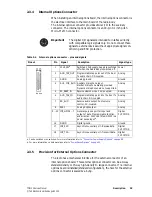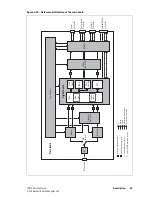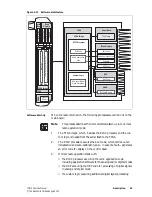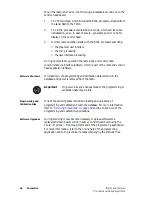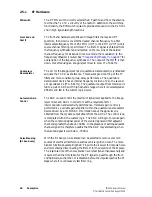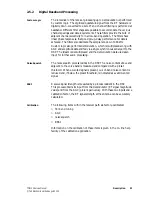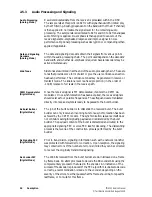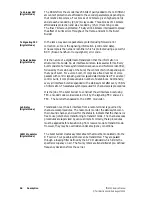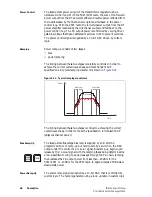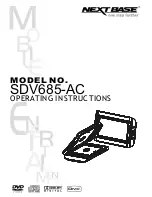
52
Description
TM9100 Service Manual
© Tait Electronics Limited
August 2005
2.5.3
Audio Processing and Signaling
Audio Processing
(Analog Mode)
Raw demodulated data from the receiver is processed within the DSP.
The sample rate at this point is 48kHz with signal bandwidth limited only
by the IF filtering. Scaling (dependent on the bandwidth of the RF channel)
is then applied to normalize the signal level for the remaining audio
processing. The sample rate is decimated to 8kHz and 0.3 to 3 kHz bandpass
audio filtering is applied. De-emphasis is then applied to cancel out the
receive signals pre-emphasized response and improve signal to noise
performance. Optional processing such as decryption or companding is then
applied if applicable.
Data and Signaling
Decoders
(Analog Mode)
The data and signaling decoders obtain their signals from various points
within the audio processing chain. The point used depends on the decoders’
bandwidth and whether de-emphasis is required. Several decoders may be
active simultaneously.
Side Tones
Side tones are summed in at the end of the audio processing chain. These are
tones that provide some form of alert or give the user confidence an action
has been performed. The confidence tones may be generated in receive or
transmit mode. The sidetone level is a fixed proportion (in the order of
-10 dB) relative to full scale in the receive path.
C4FM Demodulator
(Digital Mode)
Once the received signal is FM demodulated, it enters the C4FM de-
modulator. Once synchronization has been acquired, the received signals
should exist as four possible frequencies. These frequencies are translated
directly into received symbols ready to be passed to the burst builder.
Rx Burst Builder
(Digital Mode)
The job of the burst builder is to dismantle the received burst. The burst
builder can only receive an incoming burst once synchronization has been
achieved by the C4FM modem. The synchronization sequence itself does
not contain meaningful signaling payload and is discarded by the burst
builder. The payload content of the burst is dismantled and routed to the
appropriate signaling FEC or voice FEC task for decoding. The dismantling
process is the reverse of the construction process performed by the burst
builder.
Rx Signaling FEC
(Digital Mode)
Prior to transmission, signaling information such as the network identifier
was protected with forward error correction. Upon reception, the signaling
may contain errors. If the number of errors is limited they can be corrected
to recover the originally transmitted signaling.
Rx Vocoder FEC
(Digital Mode)
The 144 bits received from the burst builder are de-interleaved on a frame
by frame basis. An attempt is made to decode the 88 vocoder bits using the
complementary process to that used in the encoder. An indication of the
success of the decoder is produced. If the FEC algorithm is unable to decode
correctly, a recommendation is made to the vocoder, depending on the
severity of the errors, to either guess what the frame should be, to repeat the
last frame, or to mute for this frame.
Summary of Contents for TM9100
Page 1: ...TM9100 mobiles Service Manual MMA 00017 01 Issue 1 August 2005 ...
Page 4: ...4 TM9100 Service Manual Tait Electronics Limited August 2005 ...
Page 10: ...10 TM9100 Service Manual Tait Electronics Limited August 2005 ...
Page 22: ...22 Introduction TM9100 Service Manual Tait Electronics Limited August 2005 ...
Page 62: ...62 Description TM9100 Service Manual Tait Electronics Limited August 2005 ...
Page 96: ...96 TM9100 Service Manual Tait Electronics Limited August 2005 ...
Page 138: ...138 Disassembly and Reassembly TM9100 Service Manual Tait Electronics Limited August 2005 ...
Page 152: ...152 Servicing Procedures TM9100 Service Manual Tait Electronics Limited August 2005 ...
Page 168: ...168 Interface Fault Finding TM9100 Service Manual Tait Electronics Limited August 2005 ...
Page 244: ...244 Receiver Fault Finding TM9100 Service Manual Tait Electronics Limited August 2005 ...
Page 396: ...396 CODEC and Audio Fault Finding TM9100 Service Manual Tait Electronics Limited August 2005 ...
Page 420: ...420 Fault Finding of Control Head TM9100 Service Manual Tait Electronics Limited August 2005 ...
Page 426: ...426 Spare Parts TM9100 Service Manual Tait Electronics Limited August 2005 ...
Page 430: ...430 TM9100 Service Manual Tait Electronics Limited August 2005 ...
Page 444: ...444 TMAA04 05 Ignition Sense Kit TM9100 Service Manual Tait Electronics Limited August 2005 ...
Page 448: ...448 TMAA10 01 Desktop Microphone TM9100 Service Manual Tait Electronics Limited August 2005 ...


